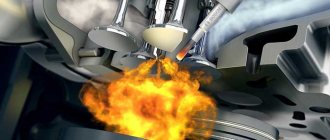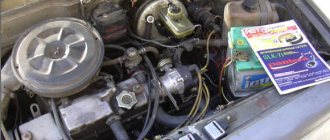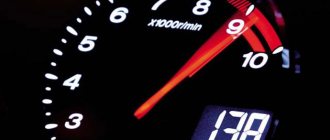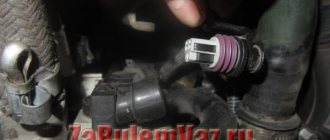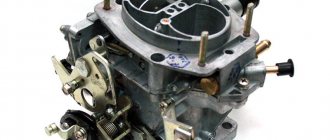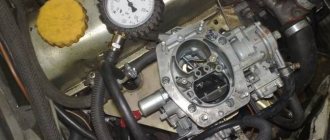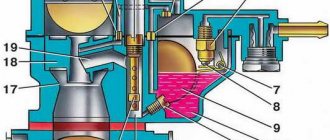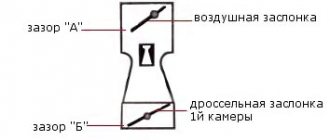Let's consider the reasons for “shooting” at the carburetor when starting or operating the carburetor engine of VAZ 2108, 2109, 21099 cars. All of them, one way or another, are associated with a strong depletion of the fuel mixture entering the engine, an incorrectly set ignition timing or a shift in valve timing. This malfunction is accompanied in some cases by the inability to start the engine, or by its unstable idling, or by a clearly noticeable loss in engine power and acceleration, constant overheating and increased fuel consumption. Pressing the gas pedal causes “dips”, “jerks” and “twitches”.
Here are some of the main reasons for “shots”, pops, “sneezing”, flashes, and ignitions in the carburetor on the engines of VAZ 2108, 2109, 2099 cars
High voltage wires are connected in the wrong order
The spark will not jump on the compression stroke as expected, but on other strokes, since the sequence of operation of the engine cylinders will not be observed. Moreover, the engine can even start and run for a while, periodically shooting into the carburetor. In such a situation, you should reinstall the wires from the spark plugs into the distributor cover starting from the installation mark on it counterclockwise in the order: 1-3-4-2. Read more: “The procedure for connecting high-voltage wires to the distributor cover on VAZ 2108, 2109, 21099 cars.”
procedure for connecting wires to the distributor cover on VAZ 2108, 2109, 21099
Ignition too late
Late ignition, when the spark jumps too late during the compression stroke and combustion of the working mixture occurs throughout the entire subsequent power stroke, and not just during compression. At the moment when the intake valves begin to open, the old fuel mixture is still burning and ignites a new portion of the fuel mixture coming from the intake manifold and carburetor on the intake stroke. There is a pop in the carburetor. A side effect is engine overheating and white spark plugs.
adjusting the ignition timing by rotating the distributor relative to the scale
The ignition distributor (distributor) is faulty
A “broken” cover, “slider”, high-voltage wires, or a faulty Hall sensor can lead to improper operation of the engine in different modes. It is also possible that the bearing holder is loose or the ignition distributor bearing itself is worn out. Read more: “Faults in the distributor of VAZ 2108, 2109, 21099 cars.” In such a situation, to quickly diagnose a malfunction, the easiest way is to temporarily replace the distributor with a known good one.
new distributor
The ignition system switch is faulty
Correct and timely sparking in the ignition system is disrupted. Replace the switch with a known good one. Article on switches: “Checking the switch of VAZ 2108, 2109, 21099 cars.”
ignition system switch for VAZ 2108, 2109, 21099 cars
The timing belt has jumped a tooth or two (the timing phases are out of whack)
This situation is possible after repairing the engine, replacing the timing belt, or when the timing belt is loose or worn. Again, combustion of the fuel mixture occurs when the intake valves are open, which is accompanied by a “shot” into the carburetor. The timing belt needs to be reinstalled. Article to help: “Replacing the timing belt on a carburetor engine of VAZ 2108, 2109, 21099 cars.”
installation marks on the shaft pulley and oil pump housing
Lean fuel mixture
If a lean fuel mixture enters the engine, flashes (popping and sneezing) in the carburetor are possible. The reason for this is the slow combustion of the lean mixture. While the intake stroke begins in the cylinder after the exhaust stroke (the intake valve opens), the combustion of the fuel mixture continues in the combustion chamber. The incoming fresh combustible mixture ignites, and combustion spreads through the intake manifold in the form of a flash, causing popping noises in the carburetor mixing chamber.
In such a situation, you should check the fuel level in the float chamber, the cleanliness of the air and fuel jets of the HDS and XX, and the presence of “suction” of foreign air. To begin with, you can simply clean the carburetor with an aerosol cleaner. If popping noises occur when you sharply press the gas pedal, check the serviceability of the carburetor accelerator pump.
carburetor cleaner aerosol
It is worth noting that a lean fuel mixture can also occur due to a malfunction of the fuel pump, clogged filters and power system lines.
Burnt out or deformed intake valve(s)
Ignition of the mixture occurs when the valve plate is not tightly pressed to the seat in the block head and is accompanied by shots into the carburetor. The valve may be bent or burnt out.
Valve failure can be determined in several ways, for example, using a compression gauge and a small amount of engine oil. All methods are described in detail on the page “Measuring compression in the cylinders of a carburetor engine.”
measuring compression with a compression meter
If a valve malfunction is detected, you will have to remove the cylinder head and replace them with new ones.
Valve clearances too small
It’s not uncommon when repairing an engine to set the gaps between the camshaft cams and valve lifters to be too low (so that the engine runs quieter and there’s less knocking under the valve cover). The result is a loose fit of the valve plates to the seats and the combustion of the fuel mixture in the intake manifold and carburetor. A side effect is the rapid burning of the edges of the valve plates and their failure. Check and adjust the thermal clearances in the valve mechanism: “Checking the thermal clearances in the valve mechanism on carburetor engines of VAZ 2108, 2109, 21099 cars.”
Typical malfunctions of the ignition system. Ignition system zil Coil zil 130
The appearance of popping noises in the muffler and carburetor is usually accompanied by a whole list of other symptoms:
- the engine “shoots” and does not start;
- work at XX is extremely unstable;
- the engine loses power and does not “pull”;
- the motor is prone to overheating;
- fuel consumption increases noticeably;
In this case, the unit’s response to pressing the gas pedal is not clear; delays and dips appear; the machine may jerk under load and in transient modes. In the language of ordinary car enthusiasts, the engine begins to “sneeze.” If the carburetor shoots when starting the engine, and the additional symptoms described above are also present, then certain elements and settings should be checked.
Diagnostics of the ignition system and OZ settings
The check should begin with the high-voltage wires of the ignition system. Violating the order of their connection will lead to the fact that the moment of spark formation on the spark plug will not occur at the end of the compression stroke, and the very order of supplying sparks to the cylinders during engine operation will also be disrupted. In this case, the engine may start, but during operation there will be shooting in the carburetor, which will be repeated at certain intervals. To solve the problem, you should connect the wires to the spark plugs, taking into account the fact that there are special marks on the distributor cover. These labels will help you make connections in the correct order.
If the engine shoots into the carburetor, the reason may be early ignition. This means that the spark appears too early. In other words, the mixture does not ignite at the end of the compression stroke, but at the moment the piston begins to approach TDC, completing the stroke.
In this case, the mixture of fuel and air in the cylinder burns untimely, as a result of which the combustion process is disrupted. The result of early combustion is a “lumbago” in the form of a pop in the carburetor. With late ignition, popping noises can go into the muffler, since combustion is still ongoing when the intake valve begins to reopen on the next stroke. Moreover, the combustion of the remaining mixture also extends to a new portion of the fuel charge, which is sucked into the engine from the carburetor into the intake manifold during intake. Under such conditions of disrupted combustion, the engine overheats. Often late or early ignition can be determined by the condition of the spark plugs. If the spark plugs are white, with carbon deposits, etc., then the OZ needs to be checked and set by adjusting the ignition timing. This adjustment is made by turning the distributor in accordance with the scale.
You should also check the Hall sensor and pay attention to the ignition distributor bearing. Problems with bearing fastening or other nuances may indicate the need to replace the distributor. Let us add that during diagnostics it is optimal to install an initially serviceable device on the car, which will allow faster and more accurate localization of faults in the ignition distributor. Similar actions should be performed with the ignition system switch. If it breaks down, sparking is disrupted and the spark itself is not supplied at exactly the specified moment.
Lean mixture: carburetor and fuel system
Running a carburetor engine on a “poor” fuel-air mixture often leads to the formation of pops and shooting in the carburetor. This phenomenon occurs because the lean mixture burns too slowly. The problem resembles an ignition failure, that is, the lean mixture burns after a new intake stroke has begun. It turns out that after exhaust, the intake valve opens on the intake stroke, and the lean fuel mixture still burns out in the combustion chamber. The incoming portion of the mixture also lights up. As a result, cotton is created in the intake, which reaches the mixing chamber of the carburetor itself. It should also be remembered that a lean working mixture is one of the main reasons for engine overheating.
It is also necessary to check at what level the fuel is in the float chamber. Another reason for a lean mixture may be air leaks. At the same time, you should check the carburetor accelerator pump, especially if shooting occurs when you press the accelerator sharply. Note that in most cases, to normalize the operation of the internal combustion engine, it is enough to clean the carburetor with a “carbicleaner” type cleaner and then correctly configure the device, as well as replace the fuel filters.
Timing faults
Special attention will be required in the case where, after carrying out any repair work or as a result of wear of the timing drive elements, shots appear in the carburetor. The most common cause is a stretched, worn or incorrectly installed timing belt. In other words, a phase failure occurred during the operation of the gas distribution mechanism, as a result of which the fuel mixture burns when the intake valves open. In such a situation, you need to accurately align the timing belt according to the marks.
Such a loose fit of the valves to the seats leads to the mixture burning out in the intake manifold and causing shooting in the carburetor. Operating the engine with the valves clamped after a short period of time causes the valve to burn out, since the edges of the plates experience severe temperature loads, the valves do not release excess heat to the cylinder head, etc. The thermal clearances of the valves must be precisely adjusted, and the settings themselves must be checked every 20-40 thousand km. mileage
Finally, let’s add that popping noises in the carburetor can be caused by a burnt-out valve, as well as other defects in the valve mechanism. In this case, the combustion chamber loses its tightness, that is, the valve plate does not completely adhere to the seat in the cylinder head. After the mixture ignites, a breakthrough of hot gases and flame occurs, and the carburetor begins to fire. To accurately determine the condition of the engine, it is necessary to measure the compression in the cylinders. Based on the results obtained and by analyzing other signs of malfunction, a decision should be made as to whether it is advisable to remove the cylinder head for repair.
Inlet valve
A bent or burnt valve is unable to seal the combustion chamber from the carburetor. Loose pressure of the plate to the seat allows gases to break into the intake manifold. In some cases, the fresh air-fuel mixture ignites.
To diagnose the problem, you need to check the compression. If a cylinder is detected with a suspected combustion chamber leak, it is necessary to fill it with engine oil. This will prevent excessive wear of the cylinder-piston group or sticking of the piston rings. A cylinder with a damaged valve shows the same compression both with and without oil.
To eliminate the malfunction, it is necessary to dismantle the cylinder head and replace the valve. If the valve is bent, it is recommended to check the correct timing of the timing belt. Burnout of the valve with low mileage also requires searching for the cause of this breakdown.
If you have hydraulic boosters, you should also check their operation. Sticking of the hydraulic compensator leads to the same consequences as burnout of the valve. In this case, shooting into the carburetor may not be observed all the time, but during certain periods, for example, when the engine is cold or hot. Very often, car owners complain that they shoot when I start the engine.
Air filter problems
An incorrect ratio of air and fuel in the fuel mixture is the most likely answer to the question “why does the muffler shoot?” If your car has a carburetor, air will have to pass through the air filter to get into the engine. When it becomes clogged, the volume of air intake per unit of time drops, which disrupts the composition of the mixture and the operation of the power unit as a whole.
Problems with the air filter lead to incomplete combustion of fuel and its residues entering the manifold and exhaust system. There, due to high temperature and pressure, spontaneous combustion and popping occurs. At the same time, when over-gasping, loud pops in the muffler occur more often, since the air-to-fuel ratio will be minimal, and the entry of unburnt mixture into the manifold will be maximum.
Doesn't develop speed
If the engine is in good working order, but the walk-behind tractor does not develop speed, then it is possible:
the air filter is clogged. As a result, not all the air enters the carburetor, and the fuel becomes oversaturated; low quality fuel fluid; parts of the ignition system have failed
As mentioned earlier, it is necessary to check the spark plug, correct the gap between the electrodes, and pay attention to the mechanical integrity of the electrical circuit; if necessary, clean the carburetor and adjust it correctly; the operation of pistons and cylinders is interconnected with engine power.
Therefore, pay attention to the condition of the pistons and cylinders. Their external damage can significantly reduce the compression value
For example, cleaning the carburetor may solve the problem
Popping sounds in the carburetor on the 402 engine
The 402 model engine was serially installed on Gazelle cars until 1985, then the Gorky Automobile Plant switched to equipping cars with 406 engines. Now thousands of Gazelles, Volga GAZ-3110 are operated by ZMZ-402. Like any gasoline engine, popping in the carburetor on the 402 engine is a frequent occurrence.
There are a lot of malfunctions that cause lumbago and popping noises. The most widespread of them:
- obstruction of fine gasoline filters and fuel pumps;
- diaphragm rupture, violation of tight fit of fuel pump valves;
- ice plugs in fuel pipes or sump;
- Gasoline supply hoses are clogged with debris;
- the carburetor air damper does not close tightly;
- The passage holes of the idle jet and the main fuel jet are coked with resins and deposits.
Lean fuel assembly
Operating a carburetor on a lean fuel assembly often becomes a source of popping noise a priori. This is due to the combustion process itself, which in this case occurs slowly. Symptoms of this type of malfunction are similar to ignition failures. The poor fuel assembly burns after a new intake stroke begins.
Lean fuel mixture
A lean fuel assembly is almost the main reason for overheating of the power plant. The pop is created first in the intake, and only then the sound is transmitted to the mixing chamber of the carb.
The root causes of the formation of a lean fuel assembly must be sought in the carburetor itself, fuel lines, filters or in the fuel pump. As a rule, this is due to air penetration into the system or clogging of the jets, which are the main components - dispensers.
It is also important to be able to check at what level the fuel is in the float chamber. Often something similar happens due to the curvature of the float.
At the same time, it would be a good idea to test the accelerator pump. This part of the carburetor can also play a role when shots appear. This is especially true if it shoots when you press the gas pedal.
Carburetor accelerator pump
If the problem is related to the carburetor and its components, then sometimes it is enough to treat the inside of the device with an aerosol spray to clean the metering devices. After that, all that remains is to properly adjust everything. It would also be a good idea to replace the fuel filters.
Shots in the carburetor often appear after repairs at a service station. A crookedly installed mechanism belt is the reason for this. Needless to say, this negatively affects the entire gas distribution process. A phase failure occurs and the fuel assembly burns out untimely.
Timing belt
The problem is “treated” by correctly aligning the belt to the marks. If the rubber has lost its original properties, then it is advisable to replace such a part with a new one.
The reasons for shooting into the carburetor and troubleshooting are clearly visible in the table.
The main reasons for shots in the carburetor
The reasons for the breakdown differ for each case. To accurately identify them, it is necessary to carry out a number of diagnostic measures. The power plant shoots into the carburetor when:
- Incorrectly selected air-fuel mixture.
- Irregularities in the ignition system.
- Incorrect operation of the gas distribution mechanism.
To identify a breakdown, no specialized education or experience in car repair is required. A sign is the presence of shots in the air filter area. When the car moves, jerks and dips are observed.
Lean air-fuel mixture
Correct operation of the power plant depends on the correct mixture of gasoline and air. If an insufficient amount of fuel is supplied, a lean mixture enters the combustion chambers.
When the piston of an internal combustion engine moves to top dead center, both valves are closed. Compression and ignition of the mixture occurs. If there is not enough fuel, it continues to burn until the suction stroke. Once the intake valve opens, the fuel in the intake manifold ignites. The rapid ignition of gasoline causes it to shoot into the carburetor.
There are several reasons why a lean mixture is formed:
- The main dosing system nozzle is clogged. Gasoline from the float chamber does not flow into the emulsion well.
- Emulsion tube clogged.
- Damage to the integrity of the accelerator pump diaphragm or piston. A sharp press on the accelerator pedal causes the throttle valve to open. Fuel from the main metering system sprayer arrives late.
- Insufficient level in the float chamber.
To eliminate the malfunction, you will need to clean the device and set the level to the correct level. Motorists use specialized cleaners. To clean, you need to remove the air filter cover. After this, start the unit and direct the aerosol stream into the working chambers.
The cleaner removes light stains. Complete disassembly of the unit may be required.
Damage to the ignition distributor cap
If the engine shoots into the carburetor, the cause may be an untimely spark supply. It slips between adjacent contacts when cracks appear in the distributor cover. This is how a spark is supplied to the spark plug when fuel is sucked from the carburetor. When gasoline ignites, it shoots into the carburetor.
In some cases, shots are observed when the distributor cap gets wet. The malfunction can be eliminated by wiping with a dry cloth.
Damage to the distributor cover requires replacement of the part with a working one. Cracks are identified by inspecting the inner surface of the lid. At the site of the spark breakdown, a grayish-white stripe will be clearly visible.
Incorrect wire connection
If the armor wire is connected to the wrong cylinder, the timing of the spark will be changed. Gasoline ignites in the intake manifold. Because of this, the carburetor will shoot. The fault can be identified and eliminated by checking and installing the wires in their places.
Spark plug failure
In some cases, the spark plug produces an unstable spark. Moreover, at moments when there is no spark, fuel accumulates in the combustion chamber. After the air-fuel mixture ignites, the fuel also ignites in the intake manifold. At the same time it shoots into the carburetor.
A faulty spark plug can be identified by the presence of black shiny carbon deposits on the electrodes. Repair involves replacing the part with a working one.
Valve malfunctions
Incorrect operation of the gas distribution mechanism leads to popping noises. There are several malfunctions that cause the engine to fire:
- Valve bend. The inlet port does not close completely at the moment of compression and stroke. In this case, the air-fuel mixture formed in the carburetor ignites.
- Incorrect adjustment. The temperature gap is necessary to avoid the valve opening when metal parts heat and expand. Some motorists reduce the gap to reduce noise levels. When the power plant heats up to operating temperature, the parts expand and the valve does not close completely.
- Pusher failure. A failed pusher prevents the exhaust valve from working properly. After the power stroke, combustion products exit into the intake manifold. During this process, it shoots into the carburetor.
Carburetor transition setting
While the engine is idling, the throttle valves are closed. A vacuum (vacuum) is formed under the dampers. Thanks to this vacuum, gasoline is sucked out through a small idle channel and nozzle, and the engine itself runs smoothly at idle. If you open the damper sharply, then the vacuum also weakens. Moreover, this vacuum is not enough for normal operation of the MDS (main dosing system) in the first chamber, and the idle system and accelerator pump are not yet capable of normalizing engine operation. In other words, when you sharply press the gas after idling, there is a delay in the response to pressing the accelerator pedal.
To minimize or completely eliminate this failure, a transition system is used in the carburetor device. This diagram is a hole-slot made above the throttle valve in the first chamber. At the moment you press the gas pedal, the slot-shaped hole appears in a zone of high vacuum, due to which intensive fuel suction occurs parallel to its supply through the idle jet.
Let's go back to the settings. After the carburetor has been installed, many cars experience a failure when starting from a stop, reactions to pressing the gas pedal are slow, and the engine may start shooting at the carburetor or stall. In such a situation, the transition system may be to blame. In order to normalize the operation of the carburetor, it is necessary to correctly select the cross-section of the “spout” of the accelerator pump and the size of the idle jet.
It is important to know that the nozzles in the first chamber do not need to be touched, and the indicated failures should not be attempted to be eliminated by replacing the nozzles of the main dosing system. To solve the problem, use the previously built carburetor to correctly select the idle jet and the accelerator pump nozzle
Selection must be carried out after the engine has warmed up, the choke must be removed
The selection must be made after the internal combustion engine has warmed up, the choke must be removed.
In practice it looks like this:
The level in the float chamber was previously set and the idle speed was adjusted. A warm engine idles normally without chugging. A stream of gasoline from the accelerator pump nozzle hits the manifold. Now you can sharply press the gas pedal. What is needed is the sharpness of the press, and not how hard the pedal was pressed (to the floor, half a stroke or ¼). Normally, the motor should immediately respond and spin up, that is, the speed increases without delays or failures. If the response to a sharp press on the accelerator is slow or there is a noticeable pause before the speed increases, then you should go to the settings.
To accurately determine the cause, you need to press the gas pedal again, but this time smoothly, not sharply
If in this case there is an even increase in speed (without pauses, dips or delays), then you should pay attention to the idle jet and the pump spout, since the main dosing system has nothing to do with the failure. If, when you gently press the gas, the engine spins up poorly, the unit itself begins to work jerkily, hums, vibrates strongly, etc., then the problem lies in the selection of jets for the first chamber
In other words, excessive enrichment or leanness of the mixture occurs after the carburetor switches to power mode after pressing the accelerator
An indirect sign of a too “rich” mixture during operation in transition mode is that the engine emits black smoke and the smell of gasoline comes from the exhaust system. The specified smoke and odor appear after sharp throttling
In other words, excessive enrichment or leanness of the mixture occurs after the carburetor switches to power mode after pressing the accelerator. An indirect sign of a too “rich” mixture during operation in transition mode is that the engine emits black smoke and the smell of gasoline comes from the exhaust system. The specified smoke and smell appear after sharp throttling.
To remove the dip, you must carefully select the idle jets to match the pump spout or vice versa. This is done until the delay disappears when you sharply press the accelerator pedal. In parallel with this, it may be necessary to re-adjust the idle speed, since replacing the XX jet will make changes to the operation of the idle system. Let us add that if the mixture remains lean and there is a dip, and the idle jet is too large and it is not possible to adjust the idle speed, then you can install a paired pump spout, after which both tubes are bent into the first float chamber.
Adjusting screws K 88A
The developers of the ZIL-130 and ZIL-131 models made sure that setting up the K 88A carburetor was not particularly difficult for the driver. For successful work, it is enough to have minimal technical knowledge and plumbing skills. However, in order to correctly and confidently adjust the Zilov carburetor, you must first understand its design. It is a two-chamber mixer, with double spraying of gasoline and a falling flow of the mixture. The cameras are manufactured in one block. In all modes they work synchronously.
Despite the fact that the K 88A is a rather complicated device, deep knowledge of its design is required more by mechanics to repair the unit. To adjust, it is enough to know the location of the parts with which this device is configured. These include screws for adjusting the quality of the idle mixture and the number of revolutions, the throttle locking screw and the jet holder.
Plant structure
The first and practically main element of a chainsaw is the engine, namely a two-stroke carburetor (see carburetor adjustment). Its direct power can be varied, it all depends on the model of the device and its intended purpose.
Chainsaw set The second no less important part of the tool is the set (saw) which consists of a chain (cutting), bar, sprocket, wheel (chain). It is worth adding to this that completely different manufacturers provide their own specific range of this headset.
It is important that it always needs to be directly selected from the specific characteristics of the engine. Since the larger the pitch of this type of headset, the deeper the chainsaw’s cut will be, one might even say that the more powerful and productive it will be. Often chainsaw owners think about why the chainsaw shoots into the carburetor, or why gasoline does not flow into the chainsaw carburetor? But do not forget that for the device to fully operate, the engine should also not be inferior to it in terms of power.
Its lubrication is carried out using special oil directly from the second tank, which is located on the hand unit. It is worth noting that the mass of this type of tank has such features that the oil and fuel intended for the engine run out at the same time.
We have figured out the general outline of the device, and most likely its basis, and now it’s time to start understanding why the chainsaw stopped working, what the reasons could be for this and how to eliminate them.
Distributor
This unit is also capable of causing untimely and improper ignition of the fuel mixture in the engine cylinders. Malfunctions of the ignition distributor include breakdown of the cover, breakdown of the slider, and oxidation of the contacts of the explosive wires.
To determine whether the distributor is the cause of popping noises in the VAZ carburetor, install a known-good unit. If the lumbago disappears, then you need to diagnose the distributor and troubleshoot it. This is the only way to get rid of pops.
“Shoots” at the carburetor, reasons
Let's consider the reasons for “shooting” at the carburetor when starting or operating the carburetor engine of VAZ 2108, 2109, 21099 cars.
All of them, one way or another, are associated with a strong depletion of the fuel mixture entering the engine, an incorrectly set ignition timing or a shift in valve timing. This malfunction is accompanied in some cases by the inability to start the engine, or by its unstable idling, or by a clearly noticeable loss in engine power and acceleration, constant overheating and increased fuel consumption. Pressing the gas pedal causes “dips”, “jerks” and “twitches”.
Here are some of the main reasons for “shots”, pops, “sneezing”, flashes, and ignitions in the carburetor on the engines of VAZ 2108, 2109, 2099 cars.
“Shoots” at the carburetor, causes of malfunction
— High-voltage wires are connected in the wrong order
The spark will not jump on the compression stroke as expected, but on other strokes, since the sequence of operation of the engine cylinders will not be observed. Moreover, the engine can even start and run for a while, periodically shooting into the carburetor. In such a situation, you should reinstall the wires from the spark plugs into the distributor cover starting from the installation mark on it counterclockwise in the order: 1-3-4-2. Read more: “The procedure for connecting high-voltage wires to the distributor cover on VAZ 2108, 2109, 21099 cars.”
The procedure for connecting wires to the distributor cover on VAZ 2108, 2109, 21099
— Ignition too late
Late ignition, when the spark jumps too late during the compression stroke and combustion of the working mixture occurs throughout the entire subsequent power stroke, and not just during compression. At the moment when the intake valves begin to open, the old fuel mixture is still burning and ignites a new portion of the fuel mixture coming from the intake manifold and carburetor on the intake stroke. There is a pop in the carburetor. A side effect is engine overheating and white spark plugs.
Adjusting the ignition timing by rotating the distributor relative to the scale
— The ignition distributor (distributor) is faulty
A “broken” cover, “slider”, high-voltage wires, or a faulty Hall sensor can lead to improper operation of the engine in different modes. It is also possible that the bearing holder is loose or the ignition distributor bearing itself is worn out. Read more: “Faults in the distributor of VAZ 2108, 2109, 21099 cars.” In such a situation, to quickly diagnose a malfunction, the easiest way is to temporarily replace the distributor with a known good one.
New distributor
— The ignition system switch is faulty
Correct and timely sparking in the ignition system is disrupted. Replace the switch with a known good one. Article on switches: “Checking the switch of VAZ 2108, 2109, 21099 cars.”
Ignition system switch for VAZ 2108, 2109, 21099 cars
— The timing belt has jumped a tooth or two (the timing phases are out of whack)
This situation is possible after repairing the engine, replacing the timing belt, or when the timing belt is loose or worn. Again, combustion of the fuel mixture occurs when the intake valves are open, which is accompanied by a “shot” into the carburetor. The timing belt needs to be reinstalled. Article to help: “Replacing the timing belt on a carburetor engine of VAZ 2108, 2109, 21099 cars.”
Installation marks on the shaft pulley and oil pump housing
— Poor fuel mixture
If a lean fuel mixture enters the engine, flashes (popping and sneezing) in the carburetor are possible. The reason for this is the slow combustion of the lean mixture. While the intake stroke begins in the cylinder after the exhaust stroke (the intake valve opens), the combustion of the fuel mixture continues in the combustion chamber. The incoming fresh combustible mixture ignites, and combustion spreads through the intake manifold in the form of a flash, causing popping noises in the carburetor mixing chamber.
In such a situation, you should check the fuel level in the float chamber, the cleanliness of the air and fuel jets of the HDS and XX, and the presence of “suction” of foreign air. To begin with, you can simply clean the carburetor with an aerosol cleaner. If popping noises occur when you sharply press the gas pedal, check the serviceability of the carburetor accelerator pump.
VAZ 2109 shoots Repair VAZ 2108 2109 21099
Thursday, June 18th, 2015
Very often on VAZ cars it happens that the engine fires. Naturally, the VAZ 2109 is no exception. The engine can shoot in two places: 1) the VAZ 2109 shoots at the carburetor. 2) the VAZ 2109 shoots at the muffler. The reasons for these two unpleasant shots are similar, although different. Let's first look at why the VAZ 2109 shoots at the carburetor?
VAZ 2109 shoots into the carburetor
1) Ignition too early. That is, a spark occurs in the cylinder even before the intake valves close. As a result, the mixture in the cylinder ignites ahead of schedule and flows into the VAZ 2109 carburetor through the holes of the intake valves. If you observe this process with the air filter cover removed, you can easily see flashes of flame from the chambers of the VAZ 2109 carburetor. To eliminate too early ignition, it is necessary to correctly set.2) The valve timing is disrupted, or in simple terms - the timing belt of the VAZ 2109 has slipped. In this case, the same story turns out - a spark is supplied when the intake valves are open. In order to check the valve timing, you need to check two marks: on the camshaft gear and flywheel of the VAZ 2109. 3) The intake valve of the VAZ 2109 is stuck or burnt out. Naturally, not every cylinder necessarily fires. The valve may stick or burn out on any of them. To check, remove the cover and turn the crankshaft by hand, visually checking the correct operation of all intake valves of the VAZ 2109 engine. 4) The high-voltage wires of the VAZ 2109 are connected incorrectly. For example, if the wires of the second and third cylinders are swapped, then shooting is guaranteed. The timing of the spark supply is different for the cylinders, so again, when the spark is supplied to the wrong cylinder, it may well be supplied at the moment when the valves are open. 5) The vacuum corrector of the ignition distributor of the VAZ 2109 is faulty. As the speed increases, the vacuum in the engine intake manifold increases and this vacuum is supplied through the tube to the vacuum corrector. If it does not work, then there will be no adjustment of the ignition timing. 6) Spark plugs with carbon deposits. If, at the moment of supplying the combustible mixture, there are hot particles left on the spark plug or the cylinder walls of the VAZ 2109, then they ignite it and a shot occurs. Also, these particles are the cause of the glow ignition of the VAZ 2109, when after turning off the ignition the engine continues to jerk. Now let’s look at the reasons why that the VAZ 2109 shoots into the muffler. As you probably guessed, the problem here is that the spark is supplied when the exhaust valves are open.
VAZ 2109 shoots into the muffler
1) Ignition too late. A spark in the cylinder occurs at the moment when the exhaust valves of the VAZ 2109 engine are already open. As a result, the mixture in the cylinder ignites later than the required moment and goes through the exhaust valve openings into the muffler of the VAZ 2109. In the dark, sometimes you can see flashes from the exhaust pipe when it’s really accelerating. To eliminate too late ignition, it is necessary to set it correctly. 2) The valve timing is disturbed, or in simple terms - the timing belt of the VAZ 2109 has slipped. The same story turns out - the spark is supplied when the exhaust valves are open. In order to check the valve timing, you need to check two marks: on the camshaft gear and flywheel of the VAZ 2109. 3) The exhaust valve of the VAZ 2109 is stuck or burnt out. Naturally, not every cylinder necessarily fires. The valve may stick or burn out on any of them. To check, the cover is removed and the crankshaft is turned by hand, the correct operation of all exhaust valves of the VAZ 2109 engine is visually checked. it may well be supplied at the moment when the valves are open. 5) The vacuum corrector of the ignition distributor of the VAZ 2109 is faulty. With increasing speed, the vacuum in the engine intake manifold increases and this vacuum is supplied through a tube to the vacuum corrector. If it does not work, then there will be no adjustment of the ignition timing. 6) Spark plugs with carbon deposits. If, at the moment of supplying the combustible mixture, there are hot particles left on the spark plug or the cylinder walls of the VAZ 2109, then they ignite it and a shot occurs. Also, these particles are the cause of the glow ignition of the VAZ 2109, when after turning off the ignition the engine continues to jerk.
To home.
No spark VAZ 2109
The operating order of the VAZ 2109 cylinders
VAZ 2109 won't start
Idle speed adjustment
One of the main diseases of Zilov carburetors is the so-called floating idle. Simply put, due to one or another malfunction in the cylinder block, the fuel mixture is of poor quality. In this case, the car will noticeably stall at idle, and the speed will noticeably fluctuate. The problem is solved quite simply. You just need to adjust the screws responsible for the composition of the fuel mixture. Let's look at the whole process step by step.
- First of all, you need to completely tighten the screw, which is responsible for the quality of the fuel mixture. After the screw reaches the stop, it needs to be loosened by 4-5 turns. Thus, you will achieve a fuel mixture that is ideally enriched for the cylinder block.
- In the same way, tighten the mixture quantity screw until it stops. The only difference is that it will only need to be loosened 3 turns.
- Now you can start the engine. After turning on the ignition, be sure to wait until the car warms up sufficiently.
- Now take a screwdriver and use the mixture screw to adjust the carburetor so that the engine runs stably at 800 rpm.
- Now close the quality screw until the engine starts to sneeze. Afterwards it should be loosened by about half a turn.
Next, tighten the quality screw until instability in engine operation appears. Then loosen it half a turn.
That's all. With these simple steps you can perfectly adjust the idle speed of your ZIL 130 or 131 cars.
High-voltage wiring and OZ
It is recommended to start diagnostics with the ignition system. All armored wires must be thoroughly tested, because disorganization of the placement of spark plug outlets will easily lead to chaos in the supply of sparks to the cylinders of the engine unit. It is when the high-voltage wires are mixed up and unstable operation of the internal combustion engine is observed, shooting into the carb, etc.
There are special marks on the ignition distributor cover. They are intended to indicate the exact wiring diagram. This point with the spark plug outputs must be checked, and only then proceed to the settings of the OZ.
If early ignition is set, then shooting into the carburetor should definitely be present. This can be explained simply - the impulse passes too quickly, the fuel assembly is ignited not at the moment the compression process is completed, but in the phase when the piston approaches TDC.
A knocked down OZ creates a situation where the mixture burns out untimely and the combustion process is disrupted. The lumbago increases and can also radiate into the exhaust system (with late ignition). The worst thing is that the burning out of the remaining fuel assemblies spreads to fresh charging doses. This mixture enters the engine from the carb during startup, and it begins to overheat greatly.
You can determine the settings of the OZ that have been disrupted by the candles, or rather, by their color. A white coating on them or the appearance of soot will be a signal for the driver, who must check and set the correct ignition by adjusting the OZ. The distributor is adjusted by turning it.
The distributor itself can also become a reason to shoot into the carb. Often it deteriorates or problems arise due to a breakdown of the cover, failure of the slider or armored wiring at the points of their connection.
It is recommended to check the magnetic regulator and pay attention to the distributor bearing. During the diagnostic process, it would be correct to use an initially functional distributor and carry out diagnostics on it. This will allow you to quickly and accurately localize device problems. The same actions are carried out with the switch, because if it malfunctions, the entire spark formation process is disrupted.
Late and early ignition
With late ignition, combustion of the air-fuel mixture occurs throughout the entire power stroke. When the intake valve opens, the burning old mixture ignites fresh fuel. The engine overheats significantly during such operation. Popping noises can be observed not only in the carburetor, but also in the muffler.
For diagnostics, it is recommended to check the set ignition timing and, if necessary, adjust it. Whitened spark plug electrodes serve as indirect evidence of late ignition.
If the spark appears too early, the fuel will not ignite in a timely manner. In this case, the intake valve does not have time to close, and the combustible mixture inside the intake manifold ignites.
Particular attention should be paid to the OZ if work was carried out to repair the ignition system. It is required to produce the moment of sparking. The ignition timing is adjusted by turning the distributor relative to the scale.
